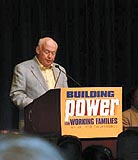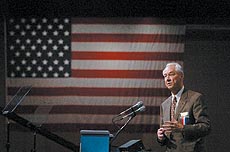AFL-CIO Convention Pursues
Progress In Wake of Split
September 2005 IBEW Journal
Even as months of turmoil ended with affiliated unions leaving the federation on its 50th anniversary meeting in July, approximately 1,000 AFL-CIO delegates got down to business and enacted a full course of changes to advance the cause of working families and goals to guide the federation’s future.
 The IBEW was well represented at the convention with nearly 80 delegates, including the International’s delegation and those members representing state federations or central labor councils (CLC’s). The IBEW was well represented at the convention with nearly 80 delegates, including the International’s delegation and those members representing state federations or central labor councils (CLC’s).
AFL-CIO President John Sweeney
addresses the convention.
Delegates adopted amendments that would rebate part of the per capita that an affiliated union pays to the federation to be used for organizing. They also funded an ongoing political mobilization program so that the movement can be ready to work for legislative and political goals on a full-time basis and not have to gear up each election cycle.
The delegates also passed an amendment giving the Executive Council the ability to create industry coordinating councils. These bodies would coordinate bargaining strategies and organizing among different unions within a common industry or for a common employer.
The convention re-elected President John Sweeney, Secretary-Treasurer Richard Trumka and Executive Vice President Linda Chavez-Thompson by acclamation. The delegates acknowledged that as the American work force changes, the leadership of the America’s largest labor federation should reflect these continuing changes. They reworked the federation’s governing structure, setting up a 20-member Executive Committee, which includes the president of the AFL-CIO, presidents of the 15 largest unions, plus four members who would bring diversity to the committee. Reflecting the loss of those international unions that disaffiliated, the convention reduced the size of the Executive Council to 46 seats from 54, reserving 15 of those seats to ensure a diverse leadership. The new Executive Council is the most diverse in the history of the AFL-CIO, and brings energy and ideas to the federation leadership.
 President Edwin D. Hill delivers remarks to the delegates. President Edwin D. Hill delivers remarks to the delegates.
Photo: Bill Burke/Page One
IBEW International President Edwin D. Hill was re-elected to the Executive Council and will serve on the Executive Committee as well. The IBEW gained a second member on the Executive Council with the election of IBEW Local 2127 Business Manager Robbie Sparks, who also chairs the IBEW Minority Caucus.
Representatives of the remaining affiliated unions adopted a resolution applauding the bravery and courage of the soldiers in Iraq, but calling for their rapid return, a break from past policy.
Much of the news surrounding the convention concerned the actions of the unions who formed the Change to Win coalition. On Sunday, July 24, the day before the convention opened, they announced that they would boycott the convention, refusing to seat their delegations or participate in the floor action. On Monday, July 25, the Service Employees International Union (SEIU) and Teamsters announced they were leaving the AFL-CIO. On Friday, the day after the convention, the United Food and Commercial Workers (UFCW) also pulled out. UNITE-HERE, another key member of the coalition, boycotted the convention but did not withdraw from the federation. The Laborers’ International Union of North America, also part of the CTW coalition, participated in the convention and remains in the AFL-CIO, but the union’s president, Terry O’Sullivan, did not seek re-election to the Executive Council.
The disaffiliations prompted immediate questions about the impact on the practical and financial operations of the central labor councils and state federations. At the convention, the AFL-CIO established a special fund to provide emergency support to state and central labor bodies and trade and industrial departments to supplement the shrinking budgets caused by disaffiliations and to fight raiding by disaffiliated or unaffiliated unions. The rules governing state feds and CLC’s also were changed to require them to perform budgeting and planning every two years.
While the convention helped to shore up resources for grassroots labor bodies, President Sweeney was clear that disaffiliated unions could not disengage on the national level but participate on the local level. In a memo to state federations and local CLC’s on July 28, Sweeney said the appeals of the disaffiliated unions for what he called “selective partnerships” on their terms with federation bodies present a direct challenge to the principles of unity and solidarity that form the foundation of the labor movement. He compared their proposals for limited cooperation to a form of free ridership: no financial support for the national AFL-CIO, no responsibilities under its constitution, but selective buy-in at the local level.
But two weeks later, after CLC’s reacted with dismay over the forced expulsions of the rogue unions, the AFL-CIO came out with a compromise proposal to allow them to participate. Under a so-called “Solidarity Charter,” unaffiliated unions could apply for memberships on state and local labor councils, but would be required to pay a 10 percent fee to the body—beyond the usual dues—to offset the cost of services provided by the national federation. Representatives from unaffiliated unions would be barred from holding top office in those councils. Locals that join would agree not to raid other unions and would promise to participate in local mobilization efforts. As this issue of the IBEW Journal went to press, it was unclear whether the proposed Solidarity Charters would be adopted by the AFL-CIO or accepted by the disaffiliated unions.
Near the end of the AFL-CIO Convention, President Hill delivered powerful remarks that serve as a guide to all in labor. He praised President Sweeney for his calm and reasoned approach in seeking to keep the federation together and also gave credit to the Change to Win unions for their ideas that sparked a needed debate on the future course of the movement. “My door will always be open; my heart will always yearn for solidarity, my plea will always be unity,” President Hill said, receiving a standing ovation. “With the understanding that there are no great principles dividing us, let’s calmly reason together, patiently work together and firmly stand as one for the mutual benefit of those people whose very lives depend on our solidarity.”
(For further information, visit the AFL-CIO Web site.)

|
